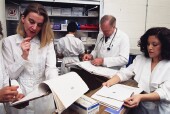
THURSDAY, Feb. 4 (HealthDay News) — As jobless Americans lost private health insurance coverage and joined the Medicaid rolls during the recession, U.S. health spending jumped 5.7 percent to $2.5 trillion in 2009, government projections show.
That means that American taxpayers will foot the bill for more than half of U.S. health care expenditure by 2012, the report’s authors said.
Overall, health care’s share of the gross domestic product (GDP) — a measure of the value of goods and services produced in the United States — climbed 1.1 percentage points to 17.3 percent in 2009.
That’s the largest one-year increase since 1960, when officials began tracking total U.S. health care spending, analysts noted in a report published online Feb. 4 by the journal Health Affairs.
“This is certainly a very steep rate of growth for health share of GDP,” said Christopher J. Truffer, an actuary in the Centers for Medicare and Medicaid Services’ (CMS) Office of the Actuary and one of the authors of the report.
Health care’s rate of growth eclipsed the rate of overall economic activity in the nation, with GDP tumbling 1.1 percentage points to $14.3 trillion in 2009.
Spending by public payers outpaced private health care spending in 2009, driven by sharp increases in Medicaid enrollment, up 6.5 percent, and spending, up 9.9 percent, the report found.
Overall, the numbers reflect both faster public health spending growth, tied to Medicaid, and slightly faster private health spending growth, but at fairly low levels compared to history, Truffer explained. “So the impact of the recession is being seen in the private health spending growth,” he said.
Health spending by private payers in 2009 grew just 3 percent to $1.3 trillion, restrained by a 1.2 percent decline in private health insurance enrollment. That decline occurred despite an increase in federal subsidies to support “COBRA,” the continuing health coverage that workers who were enrolled in their employer’s health plan may purchase after they’re laid off.
Helen Darling, president of the National Business Group on Health, which represents Fortune 500 companies and large public-sector employers that provide health coverage for more than 50 million workers, retirees and family members, said the impact of the recession on the number of unemployed who lost their health coverage “is especially disturbing.”
She said there is a pressing need to control health care costs and grow the economy.
“It is a great concern that health care spending continued to rise so sharply when the GDP declined,” Darling said. “The nation cannot afford the very expensive health care system we have.”
National health spending is projected to reach $4.5 trillion — nearly double current spending — and consume 19.3 percent of the GDP by 2019.
While both chambers of Congress have passed separate health reform measures, lawmakers remain stalled on how to advance the legislation. Therefore, the CMS report does not reflect the impact of the proposed reforms.
CMS’s spending projections, which provide an 11-year snapshot through 2019, are the result of economic modeling and judgments about future events and trends that influence health spending, the authors explained. However, the projections do not reflect the impact of any health reform proposals.
The report also finds that:
- Public health spending will accelerate in the latter years of the projection period as aging baby boomers move from private coverage into Medicare.
- Partly due to the increase in public enrollment, spending on hospital and physician services is up. Hospital spending increased 5.9 percent to $760.6 billion in 2009, up from 4.5 percent the prior year. Spending on physician and clinical services spiked 6.3 percent to $527.6 billion, up from 5 percent in 2008.
- Spending on prescription drugs rose 5.2 percent, a gain of 2 percentage points, in 2009, reflecting an increase in per-person use of drugs, an increase in the use of antiviral drugs to treat H1N1 (swine flu), and faster price growth in brand-name drugs.
“Higher price growth among brand names is likely due to new brand drugs launched with higher prices,” Darling said. She added that employers, health plans and pharmacy benefit managers have noticed significant price increases, “possibly in anticipation of health care reform and concerns about higher industry taxes.”
More information
There’s more on efforts to reform health care at the Commonwealth Fund.

